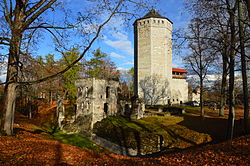Paide
This article needs additional citations for verification. (July 2013) |
Paide | |
|---|---|
 Paide castle | |
 Paide Location in Estonia | |
| Coordinates: 58°53′00″N 25°33′26″E / 58.88333°N 25.55722°ECoordinates: 58°53′00″N 25°33′26″E / 58.88333°N 25.55722°E | |
| Country | |
| County | |
| Municipality | |
| Area | |
| • Total | 10.036 km2 (3.875 sq mi) |
| Population (2020)[1] | |
| • Total | 7,793 |
| • Rank | 19th |
| • Density | 780/km2 (2,000/sq mi) |
| Ethnicity | |
| • Estonians | 92% |
| • Russians | 4% |
| • other | 3% |
| Time zone | UTC+2 (EET) |
| • Summer (DST) | UTC+3 (EEST) |
| Area code(s) | (+372) 38 |
| Vehicle registration | P |
Paide is a small city and the capital of Järva County, Estonia.
Etymology[]
Paide's German name Weissenstein (originally Wittenstein or Wittensten in Low German) means "white stone". This name was derived from the limestone used for the construction of Paide Castle. A Latin translation, Albus Lapis, has also been used.[2] The Estonian name Paide was first recorded in 1564 as Paida, and is thought to derive from the word paas, pae "limestone".
Sights[]

Paide vallitorn[]
A castle was built in Paide by order of , master of the Livonian Order, sometime in 1265 or 1266. It was from the beginning constructed around the central tower or keep, locally known as Tall Hermann tower or Vallitorn. With its six storeys, the tower has always been the core of the castle complex. The fortress was strengthened during the 14th and 15th centuries, when the surrounding walls were enlarged and towers added. It was also modernised to be able to meet the new threat of firearms. During the 16th century, the castle was again modified through the addition of outer bastions.[3]
During the Livonian War, the castle was repeatedly besieged by Russian troops, and in 1573 it was occupied by troops loyal to Ivan the Terrible. After that, the castle changed hands several times. It was also involved in the fighting during the 1600-1611 Polish-Swedish War, in the so-called Siege of Weissenstein.[3]
In 1895-1897 restoration work was carried out on the central tower and some other parts of the castle. However, in 1941, during World War II, retreating Soviet troops blew up the central tower and it was not repaired until after Estonia regained its independence, in 1990-1993.[3]
Today the restored central tower houses a part of Järva County museum.[3]
Paide Church[]
Paide Church originally dates from the 16th century; however, it has been very badly damaged in both war and fire on several occasions, and the present-day building dates mainly from a reconstruction which took place in 1909-1910 under the supervision of architect J. C. Mühlhausen.[3]
Sports[]
Paide is home to Paide linnastaadion, the home ground of Meistriliiga football team Paide Linnameeskond.
Notable residents[]
- Ita Ever, stage and film actress
- Helle-Reet Helenurm, actress
- Johannes Hesse, father of author Hermann Hesse
- Tullio Ilomets, chemist
- Ekaterina Kalinina, Bolshevik revolutionary and civil servant, wife of the Soviet head of state Mikhail Kalinin
- Carmen Kass, model
- Kalle Kiik, chess International Master
- Andres Noormets, actor and stage director
- Arvo Pärt, classical music composer
- Toomas Raudam, writer
Gallery[]

View of Paide, made sometime before 1632

Town square

Paide castle in winter
Courthouse
Hospital clinic (former German Girls' Private Gymnasium)
Paide Town Hall
Järvamaa Museum
See also[]
References[]
- ^ Population by sex, age and place of residence after the 2017 administrative reform, 1 January. Statistics Estonia.
- ^ Ühendus Weissenstein, Paide Linna Nimed (accessed 1 January 2013)
- ^ Jump up to: a b c d e Viirand, Tiiu (2004). Estonia. Cultural Tourism. Kunst Publishers. pp. 95–96. ISBN 9949407184.
External links[]
| Wikimedia Commons has media related to Paide. |
- Ühendus Weissenstein (in Estonian)
- Webcam from Paide keskväljak
- Paide
- Cities and towns in Estonia
- Castles of the Livonian Order
- Populated places established in the 13th century
- 1291 establishments in Europe
- 13th-century establishments in Estonia
- Kreis Jerwen
- Populated places in Järva County









